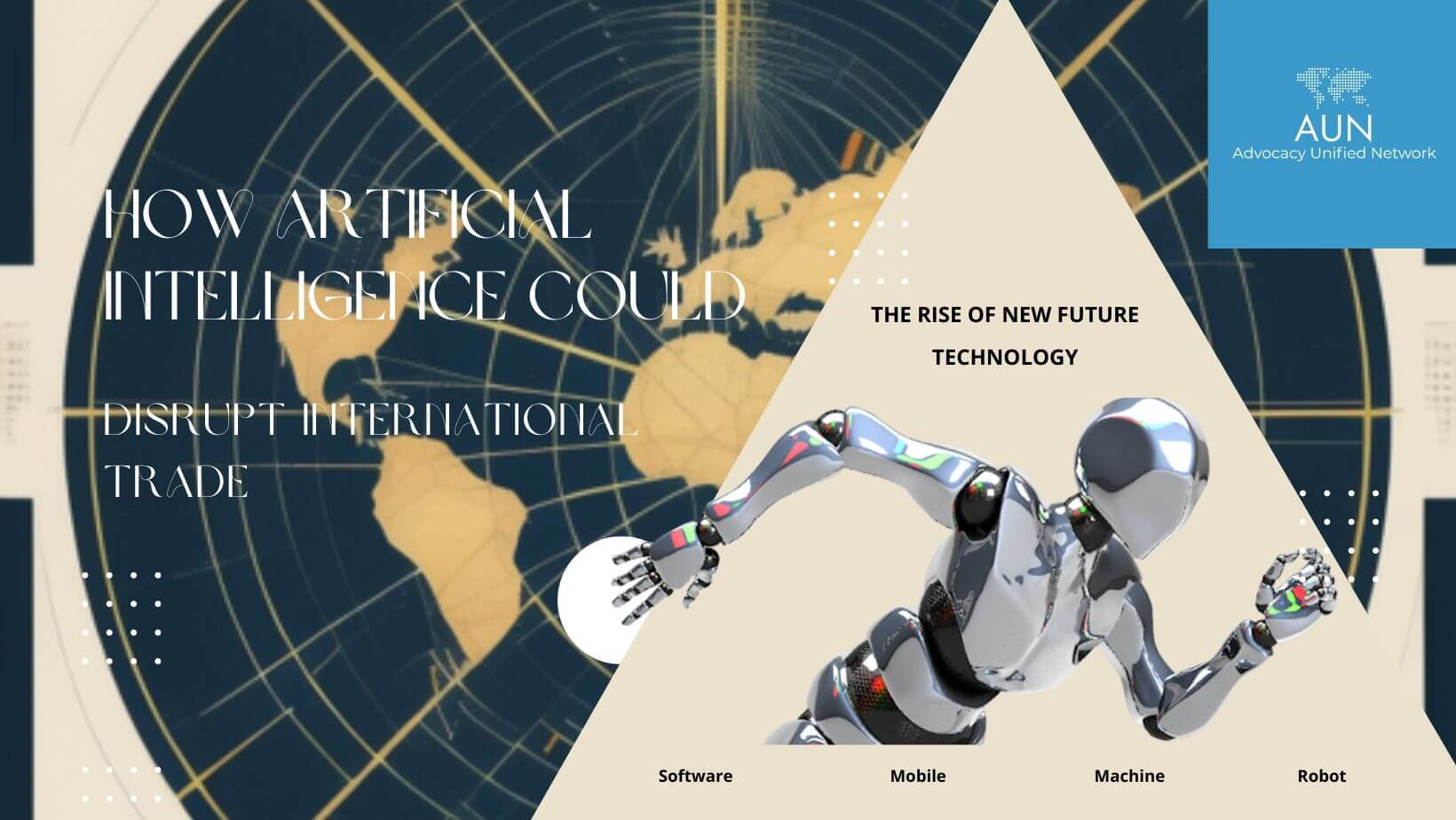The Disruptive Potential of Artificial Intelligence in International Trade
Transforming Supply Chains and Logistics: Optimising Efficiency and Delivery
AI technologies have the power to revolutionise supply chain management and logistics operations in International Trade. AI can optimise inventory management, demand forecasting, and route planning by harnessing machine learning algorithms and predictive analytics. For instance, companies can utilise AI to analyse historical data and predict demand patterns, enabling them to adjust production levels and optimise inventory accordingly. Furthermore, AI can enhance real-time tracking and monitoring of shipments, facilitating better visibility and control over the movement of goods. These advancements in supply chain management contribute to faster delivery times, reduced costs, and improved customer satisfaction.
Automation and Job Market Disruptions: Balancing Productivity and Employment
The increasing role of AI in international trade raises concerns about automation and its potential impact on the job market. AI-powered technologies have the capability to automate repetitive and routine tasks across various industries. While this automation enhances productivity and reduces business operational costs, it raises concerns about job displacement. Jobs involving manual labour or routine cognitive tasks are particularly susceptible to being replaced by AI systems. Therefore, addressing this shift in the job market becomes crucial by implementing proactive measures for reskilling and upskilling the workforce to adapt to the changing demands of the AI-driven economy.
Trade Policies and Intellectual Property Rights: Navigating Challenges and Protection
The rise of AI poses challenges to trade policies and intellectual property rights in international trade. As AI technologies advance, the protection of intellectual property becomes paramount. AI algorithms, models, and datasets are valuable assets, necessitating the establishment of clear ownership and protection mechanisms within trade agreements. Moreover, the global adoption of AI technologies can impact trade policies. Countries may implement regulations and restrictions on the cross-border transfer of AI-related technologies to safeguard national security and maintain a competitive edge. This can potentially lead to trade disputes and negotiations surrounding issues such as data localisation, technology transfer, and intellectual property rights protection.
Evolving Market Dynamics and Opportunities: Data-Driven Decision Making
While AI disrupts certain aspects of international trade, it also creates new market dynamics and opportunities. AI-powered technologies enable businesses to analyse market trends, customer behaviour, and competitive landscapes more effectively. This data-driven approach informs strategic decision-making, aiding businesses in identifying untapped markets and potential trading partners. Moreover, AI facilitates cross-border transactions by providing efficient translation services, automated contract management, and personalised customer experiences. AI-driven chatbots and virtual assistants can offer real-time language support and address customer queries, contributing to smoother international trade interactions.
Artificial Intelligence possesses disruptive potential in international trade, reshaping supply chains, impacting job markets, and influencing trade policies. By optimising supply chain efficiency, addressing job market disruptions, navigating trade policies and intellectual property rights challenges, and leveraging data-driven decision-making, countries and businesses can embrace the opportunities presented by AI while addressing potential socio-economic implications. As the AI-driven economy continues to evolve, responsible adoption and proactive policy implementation will shape the future of international trade, fostering a technologically advanced and interconnected world.
Transforming Supply Chains and Logistics

Optimising Inventory Management: Streamlining Operations and Reducing Costs
AI technologies can potentially revolutionise supply chain and logistics inventory management. By leveraging machine learning algorithms, companies can analyse vast amounts of data, including historical sales records, market trends, and customer behaviour. This analysis enables more accurate demand forecasting, allowing businesses to optimise their inventory levels. By maintaining the right amount of stock at the right time, companies can minimise carrying costs, avoid stockouts, and reduce the risk of overstocking. AI-driven inventory management systems can automatically trigger replenishment orders, ensuring optimal stock levels and eliminating manual intervention. This streamlining of operations leads to cost savings and increased operational efficiency.
Enhancing Route Optimisation: Efficient Delivery and Reduced Transportation Costs
AI-powered route optimisation algorithms enable logistics companies to optimise their delivery routes, leading to more efficient transportation and reduced costs. These algorithms take into account various factors such as distance, traffic conditions, delivery time windows, and vehicle capacity. By analysing this data and considering multiple variables, AI can determine the most optimal routes for each delivery, minimising travel time and fuel consumption. Additionally, AI can adapt routes in real time based on changing conditions, such as traffic congestion or road closures. This level of optimisation improves delivery timelines, reduces transportation costs, and enhances overall supply chain efficiency.
Real-time Tracking and Monitoring: Enhanced Visibility and Control
AI technologies enable real-time tracking and monitoring of shipments, providing businesses with enhanced visibility and control over their supply chains. Through the use of IoT devices, sensors, and AI-powered analytics, companies can track the location, condition, and status of their goods throughout the entire transportation process. This level of visibility allows businesses to proactively address any disruptions or delays and take necessary actions to mitigate risks. For example, if a shipment is delayed, AI systems can automatically notify relevant stakeholders and propose alternative routes or transportation modes to minimise the impact. Real-time tracking and monitoring not only improve supply chain efficiency but also enhance customer satisfaction by providing accurate and transparent information on the status of their orders.
Improved Customer Service: Personalization and Timely Delivery
AI technologies can also enhance customer service in supply chains and logistics. Through AI-powered chatbots and virtual assistants, businesses can provide personalised support and address customer inquiries in real time. These AI-driven tools can offer language support, provide shipping updates, and assist customers with any concerns or questions they may have. Additionally, AI algorithms can analyse customer data to identify preferences, buying patterns, and trends, enabling businesses to offer personalised recommendations and tailored experiences. By leveraging AI, businesses can improve customer satisfaction, build brand loyalty, and differentiate themselves in a competitive market.
AI technologies have transformative effects on supply chain management and logistics operations. By optimising inventory management, enhancing route optimisation, enabling real-time tracking and monitoring, and improving customer service, AI-driven solutions contribute to increased efficiency, reduced costs, and improved customer satisfaction. As businesses continue to embrace these advancements, the potential for further disruption and innovation in the field of international trade is vast.
Automation and Job Market Disruptions
Automation of Repetitive Tasks: Increased Productivity and Cost Reductions
AI-powered automation has the potential to revolutionise various industries by taking over repetitive and routine tasks. For example, AI-driven robots and machines can handle repetitive assembly line processes in manufacturing, leading to increased productivity and efficiency. This automation can also reduce business operational costs by minimising errors, improving precision, and optimising resource allocation. By freeing up human workers from mundane and repetitive tasks, businesses can redirect their workforce towards more strategic and creative endeavours.
Job Displacement and Workforce Challenges: The Impact on Employment
The rise of AI-driven automation raises concerns about job displacement and its implications for the workforce. Tasks that involve manual labour or routine cognitive activities are particularly vulnerable to automation. For instance, positions in customer service, data entry, and basic administrative tasks may be replaced by AI-powered chatbots, automated systems, and intelligent algorithms. This shift in the job market requires careful consideration and proactive measures to address the potential impact on employment.
Reskilling and Upskilling: Preparing the Workforce for the AI Era
To mitigate the negative effects of job displacement, it is crucial to prioritise reskilling and upskilling programs. By providing workers with the necessary training and education, they can acquire new skills that align with the demands of the AI-driven economy. For example, workers who were previously involved in repetitive manual tasks can be trained to operate and maintain AI systems or focus on more complex problem-solving roles that require human judgment and creativity. Governments, educational institutions, and businesses must collaborate to develop comprehensive reskilling programs and provide accessible training opportunities for individuals to transition into new roles and industries.
Creating New Opportunities: Collaboration Between Humans and AI
While AI-driven automation may eliminate certain job roles, it also creates new opportunities for collaboration between humans and AI systems. Rather than replacing humans entirely, AI technologies can augment human capabilities, enabling workers to focus on tasks that require emotional intelligence, critical thinking, and creativity. For example, in customer service, AI-powered chatbots can handle routine inquiries, allowing human agents to focus on complex and empathetic interactions. This collaboration between humans and AI can create new job roles and industries, fostering innovation and economic growth.
The automation brought about by AI technologies has the potential to disrupt the job market, particularly in roles involving repetitive tasks. However, with proactive measures such as reskilling and upskilling programs, individuals can adapt to the changing demands of the AI-driven economy. By fostering collaboration between humans and AI systems and leveraging the unique strengths of both, societies can navigate job market disruptions and harness the full potential of AI in international trade.
Trade Policies and Intellectual Property Rights
Protection of Intellectual Property: Addressing Ownership and Rights
The rapid advancement of AI technologies introduces new challenges in protecting intellectual property. AI algorithms, models, and datasets are valuable assets that require clear ownership and protection mechanisms. Trade policies need to address issues such as patenting AI inventions, copyright protection for AI-generated content, and the ownership of AI-generated works. Ensuring a robust framework for intellectual property rights in AI is crucial to incentivise innovation and encourage the development and deploying AI technologies in international trade.
Cross-Border Transfer of AI Technologies: Balancing Security and Global Collaboration
The global adoption of AI technologies raises concerns about the cross-border transfer of AI-related technologies and data. Countries may impose regulations and restrictions to protect national security and maintain a competitive edge. For example, restrictions on the export of AI technologies with potential military applications may be enforced. These measures can impact trade policies and require careful consideration to strike a balance between security concerns and promoting global collaboration. Trade agreements need to address issues such as technology transfer, data localisation requirements, and safeguards to protect intellectual property rights while facilitating the exchange of AI technologies across borders.
Trade Disputes and Negotiations: Navigating AI-Related Issues
The rise of AI technologies in international trade can potentially lead to trade disputes and negotiations. Differences in approaches to data privacy, intellectual property rights, and technology transfer can create tensions between countries. For instance, disagreements may arise when countries have contrasting policies on data protection or restrict access to AI technologies. Trade negotiations and international organisations play a crucial role in resolving these disputes, establishing common standards, and fostering cooperation. By addressing AI-related issues within trade agreements, countries can establish a framework that promotes fair competition, protects intellectual property rights, and facilitates the global exchange of AI technologies.
Collaborative Approaches: Developing International Standards
Given the global nature of AI and its impact on international trade, collaborative approaches are essential in addressing trade policies and intellectual property rights. International organisations, such as the World Trade Organization (WTO) and the World Intellectual Property Organization (WIPO), can facilitate discussions and cooperation among countries to develop common standards and guidelines. By working together, countries can establish a transparent and predictable environment for developing, deploying, and protecting AI technologies in international trade. This collaboration ensures that trade policies and intellectual property rights frameworks are adapted to the evolving landscape of AI, fostering innovation and enabling the smooth flow of AI-related trade.
The rise of AI in international trade poses challenges to trade policies and intellectual property rights. Addressing issues such as intellectual property protection, cross-border technology transfer, and trade disputes requires proactive measures and collaborative approaches. By establishing clear ownership and protection mechanisms, balancing security concerns with global collaboration, and fostering international standards, countries can navigate the complexities of AI in trade and harness its transformative potential while safeguarding intellectual property rights.
Evolving Market Dynamics and Opportunities
Market Analysis and Strategic Decision-Making
AI-powered technologies revolutionise market analysis and enable businesses to make informed strategic decisions. By analysing vast amounts of data, AI algorithms can identify market trends, customer preferences, and competitive landscapes. This valuable insight empowers businesses to adapt their products and services to meet market demands, identify new market opportunities, and develop effective marketing strategies. For example, AI can analyse social media data to understand consumer sentiment and preferences, helping businesses tailor their offerings to specific target markets.
Expansion into Untapped Markets
The data-driven approach facilitated by AI allows businesses to identify untapped markets and explore new trading opportunities. AI algorithms can analyse demographic data, economic indicators, and consumer behaviour patterns to uncover market gaps and potential customer segments. This information can guide businesses in expanding their operations into new regions, establishing trade partnerships with previously unexplored markets, and diversifying their customer base. For instance, AI-powered market research tools can help businesses identify emerging markets with high growth potential and develop strategies to enter and succeed in those markets.
Efficient Cross-Border Transactions
AI technologies enhance cross-border transactions by streamlining various processes and providing personalised customer experiences. Automated translation services enable businesses to overcome language barriers, facilitating communication and negotiation with international partners. AI-powered contract management systems can automate contracts’ creation, review, and management, reducing paperwork and increasing efficiency in international trade agreements. Furthermore, AI-driven chatbots and virtual assistants offer real-time language support, address customer queries, and provide personalised recommendations, enhancing customer experiences and fostering smoother international trade interactions.
Improved Risk Assessment and Compliance
AI can also contribute to improved risk assessment and compliance in international trade. AI algorithms can analyse vast amounts of data, including regulatory frameworks, trade policies, and risk indicators, to identify potential compliance issues and assess the associated risks. This enables businesses to proactively manage compliance requirements, mitigate risks, and ensure adherence to international trade regulations. AI-powered risk assessment systems can alert businesses to potential trade risks, such as sanctions or regulatory changes, allowing them to make informed decisions and take necessary precautions to maintain compliance.
While AI disrupts certain aspects of international trade, it also creates new market dynamics and opportunities. By leveraging AI-powered technologies, businesses can gain valuable insights into market trends, identify untapped markets, streamline cross-border transactions, and enhance risk assessment and compliance. Embracing AI in international trade can empower businesses to make informed decisions, expand into new markets, and provide personalised customer experiences, ultimately driving growth and success in an increasingly interconnected global economy.
Conclusion
Artificial Intelligence has the potential to disrupt and transform various facets of international trade. From optimising supply chains and logistics to impacting job markets and trade policies, integrating AI technologies presents challenges and opportunities. As businesses and policymakers navigate the AI-driven economy, it becomes crucial to strike a balance between harnessing the benefits of AI and addressing the socio-economic implications. By embracing AI responsibly and implementing proactive policies, countries can shape the future of international trade in an increasingly interconnected and technologically advanced world.
Author:
Arindam Bhattacharya
Chairman, Advocacy Unified Network





